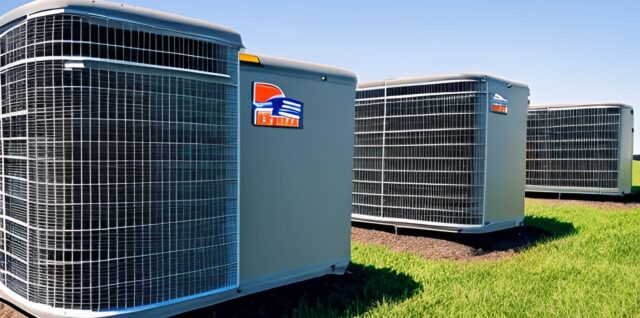In HVAC and industrial systems, precise airflow control is vital. Pneumatic and electric damper actuators are the key choices, each with its own benefits. This blog post compares these technologies, helping you make informed decisions. It also includes examples like Schneider Electric damper actuators and KMC electronic fail-safe damper actuators for insights.
Understanding Pneumatic Damper Actuators
Pneumatic damper actuators are devices that control the movement of dampers within HVAC and industrial systems by utilizing compressed air or gas. Here’s a closer look at how they function:
Working Principle
Pneumatic damper actuators operate on the principle of using air pressure to either open or close dampers.
When air pressure is applied, the actuator expands, resulting in the damper opening, and when pressure is released, the actuator contracts, causing the damper to close.
Key Components
The key components include a diaphragm, spring, and housing.
The diaphragm separates the actuator’s chambers, with one side connected to the air supply and the other to the damper.
Springs are employed in single-acting actuators to ensure closure when air pressure is removed.
The housing safeguards these components and ensures proper operation.
Advantages
Energy Efficiency: Pneumatic actuators are known for their energy-efficient operation, optimizing airflow control.
Reliable: They offer reliable and durable performance, with the ability to withstand harsh conditions.
Quick Response: Pneumatic actuators respond swiftly to changes in air pressure, ensuring precise control.
Exploring Electric Damper Actuators
Electric damper actuators, on the other hand, achieve damper control through electric motors. Here’s what you need to know about them:
Working Principle
Electric damper actuators use electric motors to open or close dampers by rotating a shaft or gear mechanism.
They offer precise control with varying degrees of rotation for modulation.
Key Components
Components include an electric motor, gears, and a control circuit.
Electric motors drive the rotation required to position the damper.
The control circuit allows for automation and integration with building management systems.
Advantages
Precision: Electric actuators provide precise control over damper positions, making them suitable for modulation.
Integration: They seamlessly integrate into building automation systems, offering centralized control.
Maintenance: Electric actuators require minimal maintenance and offer long-term reliability.
Comparative Analysis
Now, let’s delve into a comparative analysis to help you make an informed choice between pneumatic and electric damper actuators across several key aspects:
Energy Efficiency
Pneumatic actuators are known for their energy efficiency but may lose some efficiency due to air leakage.
Electric actuators are energy-efficient and do not suffer from air leakage, making them a preferred choice for certain applications.
Precision and Control
Electric actuators offer precise control and modulation capabilities, making them ideal for applications where precise positioning is critical.
Pneumatic actuators can provide adequate control but may not match the precision of electric actuators.
Reliability and Durability
Both pneumatic and electric actuators can be reliable when properly maintained.
Pneumatic actuators are durable and can withstand harsh conditions.
Electric actuators also exhibit excellent durability, with the advantage of lower maintenance requirements.
Installation and Maintenance
Pneumatic actuators are relatively simple to install and maintain.
Electric actuators offer ease of installation and require minimal maintenance.
Cost Considerations
Pneumatic actuators are often more cost-effective upfront.
Electric actuators may have a higher initial cost but can offer cost savings over the long term due to energy efficiency and lower maintenance.
Applications and Suitability
Determining the right technology often depends on the specific application. Here’s a look at where each technology shines:
Pneumatic Damper Actuators
- Ideal for applications where energy efficiency is critical.
- Suited for systems with existing pneumatic infrastructure.
- Commonly used in HVAC systems.
Electric Damper Actuators
- Preferred for applications requiring precise control and modulation.
- Suitable for integration with building automation systems.
- Used in various industries, including pharmaceuticals and cleanroom environments.
Factors Influencing the Decision
Several factors should influence your choice between pneumatic and electric damper actuators:
System Requirements: Consider the specific requirements of your HVAC or industrial system, such as the need for precise control, energy efficiency, or integration.
Control Needs: Evaluate whether your application demands modulation or simple on/off control.
Environmental Conditions: Assess the environmental conditions, as pneumatic actuators may be better suited for certain harsh environments.
Budget Constraints: Balance your initial budget constraints with long-term cost considerations.
Making the Right Choice
The choice between pneumatic and electric damper actuators is a critical decision that depends on various factors, including your specific application, control needs, and budget considerations. Understanding the strengths and limitations of each technology is essential for making the right choice. Consulting with experts or manufacturers, such as Schneider Electric or KMC Controls with their innovative KMC electronic fail safe damper actuators, can further assist you in selecting the ideal damper actuator technology for your HVAC or industrial system. By making an informed decision, you can optimize your system’s performance and contribute to energy efficiency and reliability.
